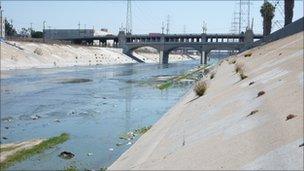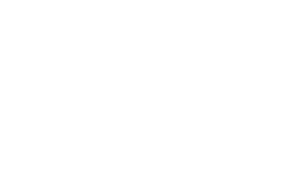Los Angeles learns to love its river
- Published
Some people in LA want to save the river, to protect it, and to improve it
The Thames, the Seine, the Danube are great rivers running through great cities. Think of Los Angeles and the riverside image doesn't immediately spring to mind.
Some people in LA don't even know the city was founded on a river, but it was and you'll probably know it when you see it.
Think of the classic Hollywood car chase: vehicles splashing through a trickle of water in a concrete storm drain, driving up the sides, dodging bridges and crashing somewhere along the way.
That's the LA river. Think Grease, Terminator 2, Transformers, and countless other movies and pop videos by stars like Madonna and Kanye West.
Hidden wildlife
For much of its 50 or so miles it looks more like a rubbish dump or a sewer, and from the air like a wide concrete scar cutting through the heart of central Los Angeles.
But two decades after the group Friends of the Los Angeles River, external was founded by a poet, the campaign to reclaim the river is starting to make some headway, and its place in the city is beginning to become a treasure rather than an eyesore.
"For 23 years we have been working to create a river greenway from the mountains to the sea, with a swimmable, fishable, boat-able Los Angeles," said Lewis MacAdams, the poet who started the campaign.
"At I first I thought all I have to do is convince people it could be better, but I realised quickly I had to convince people it even existed.
"That took a long time, but now it is in the public consciousness," Mr MacAdams said, picking his way down the concrete sides to the trees, grasses and wildlife in one of the sections with a dirt rather than concrete bottom.
It was full of wildlife - wading birds, families of ducks and geese, and a whole variety of wetland birds and plants.
"It really is a question of definition. If you see it as only a flood control channel then all these trees, these little ponds with dragon flies hovering over them are not relevant, they just get in the way of the manly art of flood control," said Mr MacAdams.
"But if you see it as a river you think there are fish and insects the fish eat, and the philosophical discussion precedes the actual work of restoration."
Race to the sea
In the 1930s two big floods across Los Angeles' wide area of wetlands forced the government to act. The Army Corps of Engineers was tasked with flood control.

Much of the river is used as a giant storm drain
It took 30 years to complete, but they concreted, dammed, drained and guided the river from the mountains to Long Beach and to the ocean.
Rail and road links were built alongside it, and the security the channel provided led to the rapid development and sprawling growth LA has seen in the last 80 years.
It doesn't rain much in Southern California, but when it does the trickle in the bottom of the canal becomes a flood and the water almost overflows as rainwater rushes off the city streets, covered as they are in tarmac and concrete, and races to the sea.
There were just a few stretches where the water table was too high for the concrete to survive. In these dirt-bottomed sections wildlife thrives, and it starts to look like a real river.
George Wolfe is a canoeing campaigner whose illegal journey down the whole length of the river had a lot to do with it being declared "navigable" just last year.
That led to the first permits being issued, on a trial basis, to lead kayaking tours down a mile-and-a-half-long stretch.
"This is an historic juncture for the city of LA - it started opening up the public's eyes to the notion you could do more recreation on the river, like boating," Mr Wolfe said, while paddling under a concrete road bridge.
"Part of all these master plans in the works with the city and county to revitalise the LA river are part and parcel with this notion of conserving water.
"Our situation with water grows more and more serious. As a city we are accustomed to taking water from elsewhere and bringing it here, while every year in LA we regularly toss out a huge, huge amount of rainfall."
A place for everyone
The 280 tickets to join the limited number of kayak tours sold out in the first 10 minutes.

Kayaking down the river is an opportunity to explore nature in the heart of the city
Those who snapped up a "golden ticket" were delighted to get on the river, rather than just walk, bike or drive past it.
"The opportunity came up so we jumped on it to see the river in its natural state in LA," said Harry Otto, kayaking with his 12-year-old daughter Carmell.
"It was always just a wash basin, there were never any trees down here when I was growing up and it's changed into an environment you want to be part of."
Some want all the concrete removed and the river turned into a place for nature and recreation - for everyone in the city.
Until the rest of the city gives up its love affair with concrete, and slows down the time it takes the storm water to reach the river, that won't be possible.
But the growing importance of ecology - and the desperate need for clean water - might just speed the process along.